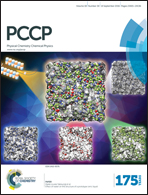Formation energies and electronic structure of intrinsic vacancy defects and oxygen vacancy clustering in BaZrO3
Abstract
Ab initio density functional theory calculations are employed for exploring the thermodynamic stability, vacancy defect formation energy and electronic structure of pristine and non-stoichiometric BaZrO3. The electronic properties of BaZrO3 show the hole-doped and insulating nature of cation and oxygen vacancies, respectively. The changes in the electronic properties of intrinsic vacancy containing BaZrO3 are analyzed in terms of electronic band structure, charge density and effective Bader charges. The relative stability of the formation of charge neutral and fully charged intrinsic vacancy defects in BaZrO3 is investigated in different chemical growth environments and the full and partial Schottky reactions are computed. Calculations are also performed to study the effects of oxygen vacancy clustering in different crystallographic planes. These calculations enable us to predict n-type conductivity in non-stoichiometric BaZrO3, which is useful for tailoring the electrical conduction of this material. Our results suggest that the semiconducting, p- and n-type character of BaZrO3 can be realized to enhance its device application by means of intentional incorporation of vacancy defects.


 Please wait while we load your content...
Please wait while we load your content...